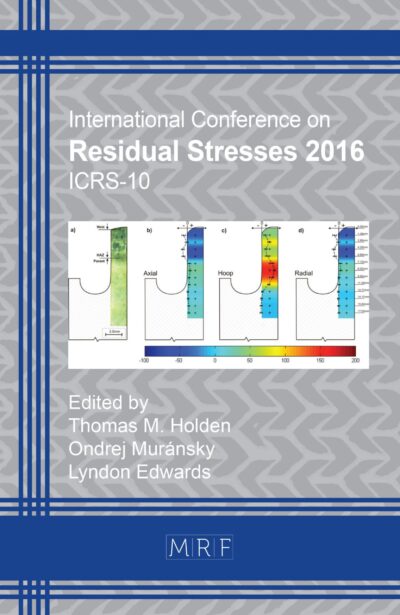Evaluations of in-process strains and residual stresses in Cp-Ti Gr 2 strips produced by large strain extrusion machining
Gursimranjot Singh Mavi, Ravinder Singh Joshi, Arshpreet Singh
Abstract. Pure titanium thin strips and sheets are widely used in the diverse fields of engineering applications: biomedical, automobiles/avionics, composites, etc. Alternative approaches to produce thin strips/sheet metal apart from rolling is severe plastic deformation techniques (SPD). One such SPD method is large strain extrusion machining (LSEM). LSEM is capable of producing stable thin sheets and strips with excellent surface and core properties: equiaxed ultra-fine grain structure. LSEM involves constrained chip formation in which the mechanics of machining is converted into constrained plastic flow. In the current study, detailed parametric evaluations at varied chip compression ratios, tool rake angles and cutting speeds of in-process strains induced coupled with machining forces have been carried out employing FEM simulations in dynamic explicit mode. Afterwards, the FEM model is transferred into quasi-static module the induced residual stresses on the produced strips (across thickness) are computed. The validity of the FEM model was established by comparing the results of induced residual stresses experimentally (through nano-indentation technique) on selected parameters and levels. The results indicate that the core residual stresses of the fabricated strips were influenced mainly by varying chip compression ratios and tool rake angles. The surface attributes and surface residual stresses were influenced mainly by varying cutting speeds.
Keywords
Titanium, Extrusion Machining, Plastic Deformation, Residual Stresses, Process Simulation
Published online 5/7/2025, 11 pages
Copyright © 2025 by the author(s)
Published under license by Materials Research Forum LLC., Millersville PA, USA
Citation: Gursimranjot Singh Mavi, Ravinder Singh Joshi, Arshpreet Singh, Evaluations of in-process strains and residual stresses in Cp-Ti Gr 2 strips produced by large strain extrusion machining, Materials Research Proceedings, Vol. 54, pp 1674-1684, 2025
DOI: https://doi.org/10.21741/9781644903599-180
The article was published as article 180 of the book Material Forming
![]() Content from this work may be used under the terms of the Creative Commons Attribution 3.0 license. Any further distribution of this work must maintain attribution to the author(s) and the title of the work, journal citation and DOI.
Content from this work may be used under the terms of the Creative Commons Attribution 3.0 license. Any further distribution of this work must maintain attribution to the author(s) and the title of the work, journal citation and DOI.
References
[1] G. Welsch, R Boyer, E.W. Collings, Materials properties handbook: titanium alloys. ASM international (1993).
[2] ASTM B61 – 10 standard Specification for Titanium and Titanium Alloy Seamless Pipe (Grades 1 to 38).
[3] A. Hanna, A. Dakhouche, K.Tirsatine, A. Sari, Y. Khereddine, D. Bradai, H. Azzeddine, Effect of hot rolling on the corrosion behavior of AZ31 magnesium alloy. Metallurgical Research & Technology 116 (2019):109. https://doi.org/10.1051/metal/2018041
[4] T.C. Lowe, R.Z. Valiev, Investigations and applications of severe plastic deformation. Springer Science & Business Media Volume 80 (2012).
[5] R.Z.Valiev, I.V. Alexandrov, Y.T. Zhu, T.C. Lowe, Paradox of strength and ductility in metals processed by severe plastic deformation. Journal of Materials Research 17 (2012), 5-8. https://doi.org/10.1557/JMR.2002.0002
[6] Y. Estrin, A. Vinogradov, Extreme grain refinement by severe plastic deformation: A wealth of challenging science. Acta materialia 61(3) (2013), 782-817. https://doi.org/10.1016/j.actamat.2012.10.038
[7] S.L. Cai, Y. Chen, G.G. Ye, M.Q. Jiang, H.Y. Wang, L.H. Dai, Characterization of the deformation field in large-strain extrusion machining. Journal of Materials Processing Technology 216 (2015), 48-58. https://doi.org/10.1016/j.jmatprotec.2014.08.022
[8] X. Yin, W. Deng, Y. Zou, J. Zhang, Ultrafine grained Al 7075 alloy fabricated by cryogenic temperature large strain extrusion machining combined with aging treatment. Materials Science and Engineering: A 762 (2019):138106. https://doi.org/10.1016/j.msea.2019.138106
[9] P. Kumar, R.S. Joshi, R.K. Singla, Sliding wear behaviour of CP titanium laminates produced by large strain extrusion machining. Wear 477 (2021):203774. https://doi.org/10.1016/j.wear.2021.203774
[10] A. Singh, Surface integrity of pure titanium strips produced by large strain extrusion machining at varying speeds. Sādhanā, 49(3) (2024), 220. https://doi.org/10.1007/s12046-024-02572-2
[11] Y. Liu, S. Cai, X. Shang, L. Dai, Enhancing surface integrity by high-speed extrusion machining. The International Journal of Advanced Manufacturing Technology 89 (2017):2141-50. https://doi.org/10.1007/s00170-016-9252-6
[12] L. Bai, K. Jiang, L. Gao, The influence and mechanism of residual stress on the corrosion behavior of welded structures. Materials Research, 21(5) (2018), e20180166. https://doi.org/10.1590/1980-5373-mr-2018-01660
[13] H. Yu, Q. Fan, X. Zhu, Effect of the layer sequence on the ballistic performance and failure mechanism of Ti6Al4V/CP-Ti laminated composite armor. Materials13(17) (2020):3886. https://doi.org/10.3390/ma13173886
[14] Q. Zheng, T. Shimizu, M. Yang, Finite element analysis of springback behavior in resistance heating assisted microbending process. Mechanical Engineering Journal. 2(1) (2015):14-00413. https://doi.org/10.1299/mej.14-00413
[15] M. Hourmand, A.A. Sarhan, M. Sayuti, M. Hamdi, A comprehensive review on machining of titanium alloys. Arabian Journal for Science and Engineering, 46 (2021), 7087-7123. https://doi.org/10.1007/s13369-021-05420-1
[16] J. Dean, G. Aldrich-Smith, T.W. Clyne, Use of nanoindentation to measure residual stresses in surface layers. Acta Materialia 59(7) (2011), 2749-2761. https://doi.org/10.1016/j.actamat.2011.01.014
[17] W.C. Oliver, G.M. Pharr, Measurement of hardness and elastic modulus by instrumented indentation: Advances in understanding and refinements to methodology. Journal of materials research 19(01) (2004), 3-20. https://doi.org/10.1557/jmr.2004.0002












